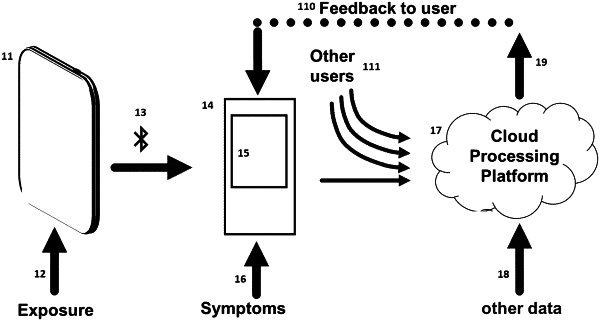| CPC G16H 40/67 (2018.01) [G01N 1/24 (2013.01); G01N 15/0205 (2013.01); G06F 16/2365 (2019.01); G16H 10/20 (2018.01); G16H 10/60 (2018.01); G16H 15/00 (2018.01); G16H 40/20 (2018.01); G16H 50/20 (2018.01); G16H 50/30 (2018.01); G16H 50/70 (2018.01); G01N 2001/245 (2013.01); G06N 20/00 (2019.01)] | 12 Claims |

|
1. A system for intelligent monitoring and management of asthma of a user of the system, the system comprising:
a wearable air quality device in the form of a hand-watch and includes a band for securing the wearable air-quality device to a hand of the user, comprising a first sensor that measures a concentration of at least one gas pollutant in ambient air, a second sensor that measures environmental data including temperature and humidity of the ambient air, and a third optical sensor that measures particulates including pollen in the ambient air, a battery that powers the wearable air-quality device, a communication device that communicates the collected exposure data to an asthma management application, a microprocessor that controls the operations of the wearable air-quality device, an inlet for sampling the ambient air, a fan that provides a controlled flow rate of ambient air from the inlet of the third optical sensor to a sensing area of the third optical sensor, and an energy management system that intermittently controls the fan to minimize energy consumption of the battery;
a mobile device of the user on which is installed the asthma management application; and
a cloud processing platform,
wherein the wearable air quality device collects user exposure data comprising the concentration of the at least one gas pollutant, the temperature and humidity, and the concentration of the particulates and pollen in the ambient air, and transmits the collected user exposure data to the asthma management application via the communication device,
wherein the asthma management application includes a user symptom interface that receives asthma symptom data from the user, including a frequency of breathing difficulties the user experienced during the last 24 hours,
wherein the asthma management application receives the user exposure data from the wearable air-quality device, and transmits the user exposure data and the asthma symptom data to the cloud-based processing platform,
wherein the cloud processing platform includes at least one cloud database and at least one cloud software that stores and processes the user exposure and the asthma symptom data, analyzes the user exposure data, the asthma symptom data, and the data in the at least one database, and provides a risk analysis report to the user via the asthma management application, the risk analysis report including a visual display in a screen of the asthma management application of a next-day risk based on a location the user selects to visit the next day and a level of activity planned by the user in the selected location,
wherein the at least one gas pollutant is one of ozone O3, sulfur dioxide SO2, nitrogen oxides NOx, volatile organic compounds VOCs, ammonia NH4, carbon dioxide CO2, and carbon monoxide CO,
wherein the risk analysis report further includes recommendation on whether the user should reduce a duration of a planned next-day activity, or limit duration of exposure at the selected location, and wherein the user mobile device is a smart phone,
wherein the at least one cloud database stores:
a pollen database storing the user pollen concentration data,
a gas pollutant database storing the user gas pollutant concentration data,
a particulates database storing the user particulates concentration data, and
an environmental data database storing the user temperature and humidity data,
an asthma symptom database storing the user asthma data,
wherein the at least one cloud database provides and stores data to and from the cloud software, and
wherein the cloud software comprises:
a sensitivity matrix module that calculates a sensitivity of the user to various asthma symptom triggers based on the recent cumulative user exposure data and the user symptom data;
symptom/exposure correlation software that correlates exposure to symptom histories, and predicts next day conditions of the user based on their current sensitivity matrix and next day weather predictions;
a risk analysis module employing a risk matrix that correlates user asthma symptoms with user activity including intensity and duration of the user activity, and generates a location-based estimate of asthma risk, by taking into account the user exposure data and the user exposure symptom data and the calculated user sensitivity to the various asthma symptom triggers,
wherein the cloud software further determines pollen type and concentration levels based on historical pollen data including monthly averaged pollen type and concentration, and historical environmental data including temperature and humidity, by employing Machine Learning regression approaches for the current month and environmental data.
|